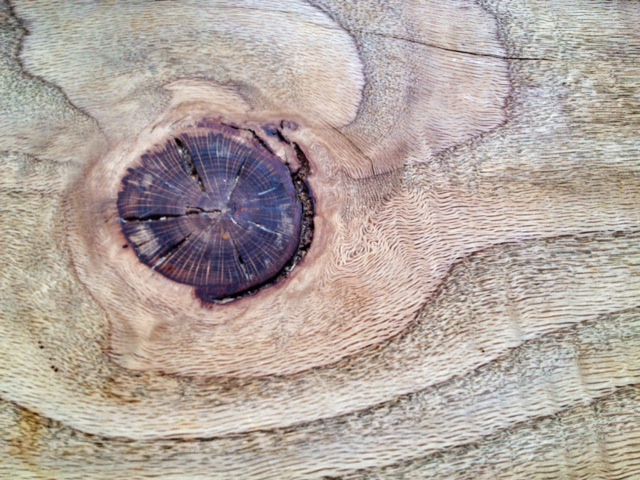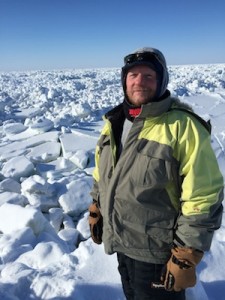
When I was a boy, I felt that the role of rhyme in poetry was to compel one to find the unobvious because of the necessity of finding a word, which rhymes. This forces novel associations and almost guarantees deviations from routine chains or trains of thought. It becomes paradoxically a sort of automatic mechanism of originality. I am pretty sure that this “habit” of originality exists in mathematical research.
—S. Ulam, Adventures of a Mathematician
I see heart attack in wood, eddies and contrails, white noise and signals, where an entire plank of pine is an oscilloscope, tracing out lignified sound and action potentials.
Explosions in timber propagate shock, where an innermost knot throws out waves of itself, hoops of stripe and shady bands of time, interspaced with the normal nothing, then hoop, then nothing, till . . . reverse grain is coming. I have seen knots inside myself, through an MRI, plumbing innards and making inner surfaces where none existed, scanning the microns of me, the possessions tucked inside.
I look for grain equivalence to Jimi Hendrix, Arvo Pärt’s Speigel im Speigel, the final note of “A Day in the Life” while staring at floors and chest-of-drawers, ceilings in restaurants, desks during meetings; many feel I’m very patient. A solid chair, Doric in character, has a back full of fine fuzzy lines, knots the shape of hieroglyphic eyes, or shot pattern, fish finder, simple v-shaped birds on the fly. Two barber pole lines run down one side.
My short film, never made, would have displayed nothing but figures in furniture, pallets and ceiling fans with razor mottle, ribbon stripe, flutes down dowels and would use sound to translate rings and ripples. Slowly zooming-out from knots, we see the widening breath of gnarls encircled by growth rings the shape of a magnetosphere and caught by the sound of a pebble dropping into a still pond. The watery capillary waves are in floorboards and wooden library card catalogs. We see figures in panel compress into bow shocks, iron filings arched by some alluring vigor. Another pebble: solar flare in cat’s paw while magnetic shivers broaden down beams where lines of force, this time, were affected by a slight solar breeze that makes cusps and tails, auroras of a dormant bud. There are stethoscope sounds of moist rales in spalted wood, miasma rising in cough, ending with the slight spark-tick from a cigarette inhaled too crisply.
Long weighty wooden I-beams in an Anchorage diner display sinus rhythms of an EKG, Jupiter’s Great Red Spot, tentarch and whorls of fingertips. In the weathered wood of the interior of old barn in Upstate New York, the slowed-down sound of a splash captures the cataclysmic grain of walnut burls—torrid spastic fibers in this wart-like growth are an upheaval of life, war, the place where Pharaoh’s army drowned. And in the only non-wood figure in this film, the writhing of a drop of rubbing alcohol on a wet sink, we would witness miniature moments of Moses parting the Red sea, then the boiling collapse of radiant lines, charging parallel spiky indents to quaking bee’s wings to blister and pocket.
One summer when I was a kid of 13 or 14, just doing nothing during a warm evening, my friends still home having supper, I walked around our garage, full of wood and chisels, paint and vacuum tubes, scrapes of metal, and loads of nails—all at my disposal. Grabbing a piece of wood, I stared. It seemed so useless, the “it” being wood (although I watched my dad transform a similar piece into a bird of prey, burnished by propane, wire-brushed to revel in its feathers of grain), the “it” being me (although I was not really feeling useless). What seemed senseless was the need for a spark but not having any or knowing how to get it. And it was not so much senseless as it was a feeling of futility. Even before starting, I wonder the “why” of doing. And hope for some divine mistake.
 Todd’s a biologist living in Barrow, Alaska. He has an MFA in creative writing from the University of Alaska Fairbanks.
Todd’s a biologist living in Barrow, Alaska. He has an MFA in creative writing from the University of Alaska Fairbanks.



An essay bordering on prose poetry, with wood as a metaphor, from a writer who lives well north of the Arctic Circle, in a land without trees…. And an essay with an ending that will resonate with writers from all latitudes.